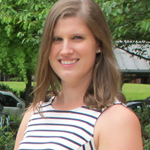GTF Hearings Officer Engages Students in More than Just the Conduct Process
 Third-year law student Alexandra Bodnar believes in process. Bodnar is a GTF hearings officer in the Office of Conduct and Community Standards, and former student representative on the University Hearings Board. In both cases—now as an individual administrator, but first as part of a panel that comprised faculty, administrators, and students—Bodnar adjudicated cases of misconduct against students.
Third-year law student Alexandra Bodnar believes in process. Bodnar is a GTF hearings officer in the Office of Conduct and Community Standards, and former student representative on the University Hearings Board. In both cases—now as an individual administrator, but first as part of a panel that comprised faculty, administrators, and students—Bodnar adjudicated cases of misconduct against students.
“I was drawn to this position because it’s a way to get outside the law school and connect with the larger campus. And it makes me feel like I’m helping students—the Student Conduct Process is a good one, and it can help students, perhaps for the first time, articulate why it matters that they’re here at UO,” Bodnar says.
Part of Bodnar’s work involves hearing cases of academic misconduct like cheating and plagiarism, which students can opt to resolve with their individual faculty members, if the faculty member is willing, or with an individual hearings officer like her, or with a panel that includes other students. Bodnar and other hearings officers determine whether academic misconduct has occurred; if so, they can impose educational penalties like insisting that the student participate in community service or workshops, or that they write papers designed to get them to engage with the conduct code, learn about research and citation practices, and reflect in writing about what’s brought them to this point. In addition, the student’s faculty member determines a grade penalty, which might mean failing the assignment or even the course. Bodnar’s decisions cannot be appealed. (Students can appeal decisions by the Hearings Board, which has a broader range of penalties it can impose, including suspension and expulsion.)
“We’re bound by the Student Conduct Code, but no case fits the code perfectly—it’s our job to interpret it,” Bodnar says. “This is a process that a student can engage in—not just a decision ‘happening’ to them—I know I don’t like feeling like things ‘just happen’ to me,” she adds.
For example, Bodnar points out that students who engage in the Conduct Process get full access to their conduct records—“they can see everything I see, which legitimates the process,” she says. Students can bring witnesses or a trusted adviser, who might be someone from the Office of Student Advocacy, to the meetings or panel hearing, “This is how you handle situations in life— you find out ‘what are my rights, what are my responsibilities?’” Bodnar says.
“Sometimes you can just tell that none of this—this meeting, the consequences of their actions, the seriousness of the University’s policies—occurred to them before,” she reflects. “I ask them, ‘What are your goals here? What does your degree mean?’
And I say, ‘I’m going to ask that and sit here and be quiet while you come up with an answer.’” She says this questioning starts a crucial thinking process, one that is elided when students come to university as an expected next step after high school—a step they haven’t examined critically.
When they articulate answers, Bodnar can ask, “Are the choices you’re making consistent with what you’ve just told me?”
Bodnar says the students she sees don’t commit academic misconduct because they’re “bad people”—instead, they typically have experienced problems with stress management or planning ahead. “For whatever reason, some students’ hearts are in the right place, but they just don’t ask the right questions of the faculty—don’t take the extra steps to figure it out what their faculty members expect of them on an assignment. Sometimes they don’t feel comfortable reaching out for help simply because they haven’t done it before.” She says engaging in the student conduct process can, at its best, be powerful delayed training in asking questions, understanding the reasoning behind class and University policies, and becoming more active in one’s own education.
“It really matters for the students to have somebody hear them out—somebody who wants to hear what they have to say,” Bodnar says. She says she’s proud to be that person for the students with whom she works. “If a student doesn’t cite her sources because her grandmother is in the hospital, well, that’s still plagiarism, but it’s also part of the story.” Bodnar says she wants to tell students, “I also see the good things you’re doing here—let yourself be that person. You’re going to address this issue, process it, move on, and reconnect to the rest of your education.”
—Eugene, Oregon, May 2013